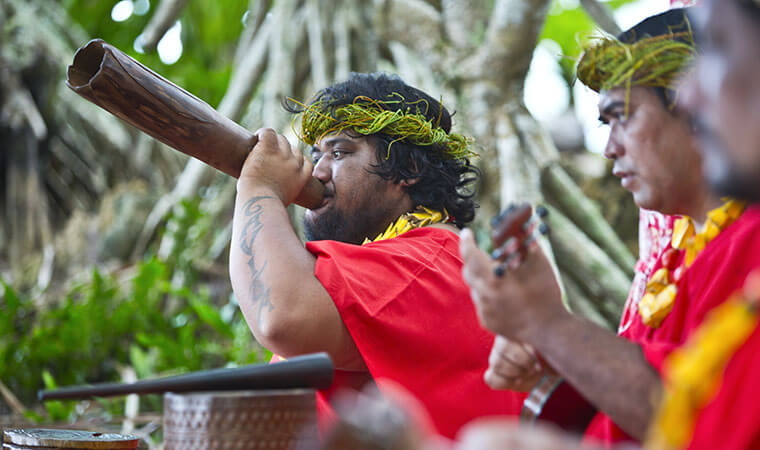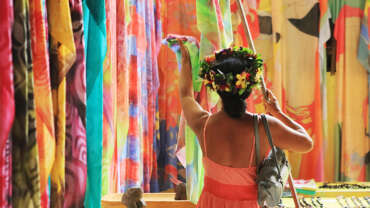Tahiti and French Polynesian Cultural Tourism
Tahitians today have inherited a rich, expressive Tahitian culture from their Mā’ohi ancestors. From the Mā’ohi came the pulse of Tahitian lifestyle, a world where the lives of gods, warriors and men crossed in colorful legends. Tahitian culture is a place where the French Polynesian traditions of music, dance and art rose from the wonder of everyday island life. Tahiti’s culture is also where javelin throwing began as the sport of the gods, kings favored surf riding and men competed in canoe races and stone lifting as a show of pure strength.
Tahiti Culture: Mana
Strength, power, influence, supremacy, greatness, sovereignty, omnipotence, prestige, control, genius, authority, superiority, nobility, stature, presence, elegance, beauty … the list goes on and on.
These words define the Mana in a precise situation, a particular context, from a specific point of view. Mana is a mythical and essential concept in Tahiti culture, a fundamental truth. It’s both tangible and intangible, expressive yet imperceptible, revealing but enigmatic, so natural but also mysterious and esoteric.
Mana lives, animates, raises up, ennobles and transcends every thing, every being, every element in every dimension; it can also annihilate, ruin and destroy until the last vital vibration.
Mana is seducing, enchanting, glamorous, penetrating, fascinating. The Mana is frightening, dangerous, consuming, lethal.
It is the root of the duality of life and death.
It is the essence of the universal power, the heart of the Polynesian universe and Polynesian culture, the beings bringing it to life, the elements shaping it, the existential, cultural and spiritual values which created the Polynesian/Mā’ohi who glorifies this universe.
The Mana is purity (ma); it arises from the life, humility, respect, dignity, love, sharing, beauty, goodness and peace of the beings and things that merge harmoniously in this Mā’ohi universe.
The Mana is wisdom (na/na’a); it emanates from the empirical, technical and ancestral knowledge, from the common sense arising out of the inalienable link between man and his environment for the people of Tahiti, from the faith in the divine, the state of grace that every thing and every being can reach through a spiritual, cultural and profane quest for the universal Mana, the promise to be reborn wiser, purer and more powerful.
Be pure, be wise and the Mana will live in you!
Tahiti Tattoo: The Tradition of Polynesian Tattoos
The word tatau originated in The Islands of Tahiti, and the symbols have meaning and the meaning tells the story of each Tahitian’s personal history. In each line drawn on the body, the ma’ohi of the past is connected to the Mana of the present and future. Tahitian people believe in the presence of Tohu, the god of tatau, who painted all the oceans’ fish in their colors and patterns, gives each tatau an essence of meaning and life. A link between heaven and earth. Polynesian tattoos are also signs of beauty, and in earlier times were an important part of life as they signaled the end of adolescence.
Mythical Origins Of Tahiti Tattoo
There are a multitude of legends concerning the origins of the tatau. They all have one point in common: they are always a gift from a god to man. On the island of Tahiti, one of these legends tells how the first tatau were done on the sons of the god Ta’aroa, the supreme creator god of everything in the Polynesian firmament. The sons taught it to other men who made extensive use of it. As a result, the two sons of Ta’aroa, Matamata and Tū Ra’i Pō became the patron divinities of tattooing.
Historical Origins Of Tahiti Tattoo
The origins of tattooing in Tahiti culture are quite vague, no doubt going back to the beginning of the māori civilization. Tattooing was probably already in existence among the successive waves of peoples who migrated from South East Asia, first to the eastern Polynesian islands, then the western islands, beginning in the second century BC. The practice seems to have existed in all the islands known jointly as the “Polynesian triangle,” an area bounded by today’s French Polynesia, New Zealand, Hawaii, Samoa, Easter Island and the Cook Islands. Tattooing was widely practiced in Tahiti traditions and found in particular forms throughout French Polynesia, with the exception of the south of the Austral Islands and the east of the Tuamotu Islands. It was in the Marquesas Islands that the art of tattooing reached its peak of development in terms of its great richness and the complexity of its motifs.
Polynesian Tattoo’s Role In Traditional Society
In pre-European Polynesian society, tattooing constituted a valuable social marker. It could indicate one’s exact place in a territory, tribe and family and one’s level on the social scale. It could also mark the accomplishment of important social rituals such as the passage from childhood to puberty or marriage. It also could represent remarkable events in the life of the person concerned: acts of bravery in war for Polynesian men or prowess as a hunter or fisherman. And it could be simply decorative. Its use was very widespread.
“Tattooing is not compulsory, but it would not have been considered acceptable for a Tahitian to have no tattoos at all,” explained anthropologist Anne Lavondes, writing about tattooing in the Society Islands.
Different Types Of Tahiti Tattoos
One can distinguish three types of Tahitian tattoo: those intended for gods, priests and ari’i, which are hereditary and therefore reserved for their descendants; those of the hui ari’I type, reserved for chiefs (Tahitian men and women); those of the hui to’a, hui ra’atira and ‘īato’ai, manahune types, for war leaders, warriors, dancers, rowers and the like.
Tahiti Sacred Tattoo
One of the fundamental aspects of Tahiti tattooing was its sacred nature. Believed to be inherited from the gods, tattooing carried with it supernatural power. Certain motifs were thought to protect man from the loss of his mana. They also represented the prestige and divine essence responsible for a Polynesian man’s health, or of his equilibrium and fertility and from harmful influences.
Tahiti Tattoo Role In The Afterlife
Tattooing also went far beyond the life of this world. Being eternal, “this inalterable work inscribed on their skin would later bear witness to their origins, rank and heroism when they were called to appear before their ancestors: the gods of the mythical country of Hawaiki,” explained Karl Von Den Steinen, a German ethnologist who undertook a detailed analysis in 1897-8 of the various forms of artistic expression of the peoples of the Marquesas Islands, including tattooing.
Tahiti Tattoos Specific To Each Archipelago
The different Tahitian populations each developed their own specific designs and particular motifs. In the language of the Marquesas, tattooing is called patu tiki, which means “stamping with images.” On this archipelago, the body could be entirely covered with tattoos, including the face. On the other hand, in the Leeward Islands, the face was never tattooed. Unfortunately, much of the meaning of the motifs and designs has been lost over time.
The Tools Of Traditional Tahiti Tattooing
The tools of traditional Polynesian tattooing comprised a small serrated comb, made of bone, tortoiseshell or mother-of-pearl, fixed to a wooden handle. The teeth were soaked in ink based on charcoal from the ti’a’iri, or candlenut (Aleurites Moluccana), diluted in oil or water. The teeth were placed on the skin while the tattooist struck the handle with another piece of wood, causing the skin to break and the ink to penetrate. With these traditional tools, producing a tattoo could be extremely painful and took days, weeks, months or even years. This reinforced the role of the Tahiti tattoo as a rite of passage.
Tahiti Tattoo “Priests”
Being responsible for this delicate operation, the priest tattooist known as tahu’a tatau, in the Society Islands and tuhuka patu tiki in the Marquesas Islands, was paid handsomely and enjoyed great respect in traditional Tahitian society. This status was often passed down from father to son.
Prohibition Of Tahiti Tattoo
As soon as they settled permanently in the Polynesian Islands at the end of the eighteenth century, both Catholic and Protestant missionaries fought against the practice of tattooing. Pōmare II, the second “king” of the dynasty of the same name, converted to Catholicism in 1812 and in 1819 drew up a code of rules which including the banning of tattoos. It is described as a practice which must be “completely abolished” as it “belonged to ancient and bad customs.” As Polynesians now had to be fully clothed in the newly Christianized society, the very raison d’être of tattooing was largely disappearing. Consequently, the great majority of motifs as well as the technique itself of tattooing were lost forever.
Tahitian Tattoo Renewal
At the beginning of the ’80s, the tatau once more occupied a major role in Polynesian society as this secular practice was re-appropriated and renewed. Of course, its sacred nature and role as a social marker, fundamental to traditional society, were considerably dimmed. Tattooing for the people of Tahiti became the bearer of a determined reclaiming of the Polynesian identity, to which was obviously added an aesthetic dimension. Now, many young Polynesians get themselves tattooed.
Having explored and researched to try to rediscover the original meaning of the motifs – a meaning which has been completely lost for many of them – the Polynesian tattooists are now developing their art in three main directions: the reproduction of traditional Tahitian tattoo motifs, the creation of strictly decorative motifs (such as dolphins or manta rays) and some have created motifs which are completely new, yet directly inspired from Tahiti tradition.
International Recognition Of Tahiti Tattoo
Tattooists are now at work in nearly all the main inhabited islands of French Polynesia. Their reputation and the beauty of the Polynesian tatau are such that they attract visitors from elsewhere. Some Polynesian tattooists practice their art in many major cities of the world such as Paris, London or New York. Polynesian tattooing has gained an international reputation both because of its traditional roots and its very fashionable ethnic aesthetic.
French Polynesian Music and Dance
When the missionaries came to Tahiti, they tried to suppress the powerful, life-affirming and sensual sounds and movements that embody Polynesian music and Tahitian dance. In the dance and rhythms, Tahitians give voice to their Mana, allowing it to rise from the sea, descend from the hills, and emanate from the soul of every Polynesian man and woman who falls under its mesmerizing spell. Today’s Tahitian dance and Tahitian music celebrates the resilience of Polynesian culture to overcome and maintain their sacred expressions of life. In ancient times, Tahitian dances were linked with all aspects of life. One would dance to welcome a visitor, to pray, to challenge an enemy or to seduce a mate.
Today’s dance remains a powerful, potent symbol, especially when accompanied by the harmonic voices of the Tahitians, the thunder of traditional drums and plaintive song of conch shells.
Tahitian Music & Song
Traditional Tahitian Instruments
Today’s orchestras use percussion and stringed instruments. Among the percussion is the to’ere; the fa’alete; the pahu with two skins and beaten with a stick and the pahu tupa’i rima, with one skin, that is played with the hands. The stringed instruments consist of the ukulele and the guitar.
Other instruments that had long disappeared from Tahiti culture have progressively made a come-back, those such as the ihara, a split bamboo drum and the vivo, a nasal flute. Finally, all sorts of sounds are obtained by clacking stones, from shells, by using penu (pinion) or coconuts.
Other chants were secular and accompanied the events of everyday life. There are sound reminiscences of collective activities such as beating tapa (bark cloth). In the Marquesas Islands, the chants in religious ceremonies were often only understood by the priests, and were accompanied by drums and handclaps.
During the festivals of Tahitian tradition, the chants progressively accompanied the beat initiated by the pahu drums. The rupture with the Polynesian cultural past is most profound in the domain of music. Perhaps this is because no one bothered to write it down or perhaps it’s because the European influence was imposed very early on without violence.
The European influence started with sailors and their profane songs and music. It continued with the missionaries who brought their canticles and hymns. The himene is a cross between the religious hymns imported by the first Protestant missionaries and polyphonic Tahitian chants that were sung before the arrival of Europeans.
The main forms of himene are himene tarava, himene ru’au and ute. The first two are rooted in English Protestant liturgy and in the pre-European period. Both types of musical expression generally praise a legendary god, a famous chief or protective animals. These songs use very poetic lyrics. Each island and district has its specific interpretations.
Tahitian Dance
In pre-European Polynesia, dances “were many and varied” (W. Ellis, 1831), but little else is known about them. All we know is that both Polynesian men and women danced, together or separately. Certain dances were performed standing up, others sitting down. Musicians used to accompany the dances with a limited number of instruments, essentially the pahu (drum with two skins) the vivo, a nasal flute.
Associated, as was tattooing, with nudity and therefore with immodesty, dancing was forbidden by missionaries. It was not until the 1950s that this ancestral art found its place again among Polynesian customs, and was reborn thanks to Tahitian natives’ oral transmission and the writing of travelers.
Types Of Tahitian Dancing
In Tahitian dancing today there are, four types of dance.
The Otea: this must have been originally a somewhat military dance among Tahitian natives, reserved for men. It has become the most famous of the Tahitian dances. It is choreographed around a theme and its musical accompaniment is performed on percussion and made up of rhythmical motifs called pehe.
The Aparima: in this dance, the hands of the Tahitian dancers mime history. The aparima can be either vava (silent) and consist of pantomime, generally performed while kneeling and accompanied by percussion or it can be sung, aparima himene, and the movements are in time to the chant which is accompanied by stringed instruments.
The Hivinau: during this choreography, male and female dancers wend round in a circle and a male soloist voices a phrase that the choir takes up. The orchestra is made up of various drums and the pace is maintained by the dancers’ songs.
The Pa’o’a: this dance seems to be derived from the movements used to make tapa (a sort of parchment made from vegetable matter). Male and female dancers crouch down in a semi-circle. A male soloist voices a theme that the choir answers. A couple get up and perform a short dance in the circle to the sound of ‘hi’s and ‘ha’s.
The other archipelagos were greatly influenced by Tahitian dancing, but they have preserved certain of their own dances such as the bird dance in the Marquesas, kapa in the Tuamotus and pe’i in the Gambiers.
Tahitian Flowers
Tropical flowers seem to be everywhere on the islands, particularly in Tahitian hair. The famous tiare Tahitian flower is used in leis to welcome travelers and returning family. Tahiti tradition holds that if they are taken, French Polynesian women and men should wear a flower behind the left ear.
Tahiti Tradition: Crafts
The art of plaiting is found in various forms such as hats, bags baskets, mats etc. The French Polynesian women from the Austral Islands are noted as experts of this discipline that uses vegetal fibers from the screw pine, the coconut or the reed or a’eho.
The taste for observing and loving nature is revived in the sumptuous tifaifai or bed covers with hand-sewn vegetal or ethnic motifs. In Polynesian culture, the enthusiasm of the women for this typical element of the decoration of fares or Polynesian homes is evidence of real creativity and has given rise to the organization of an annual show of tifaifai. Artistic expression also finds an outlet in woodwork, the prerogative of the men.
They sculpt, according to their inspiration, and according to ancestral, diagrammatic or symbolic patterns in precious wood: tou or local palisander, miro or rosewood. The Marquesans excel in this domain and produce superb pieces of work, spears, puzzles and umete which are fruit bowls in which special meals can be served.
Certain craftsmen sometimes resort to volcanic rock, corals and even bones to fashion a thousand decorations and useful items such as penu or pestles. Finally the revival of mother of pearl really shows the iridescent effects of the polished insides of shells. Their ever-changing, fascinating shades have made them choice decorative items to beautify dance costumes or make sparkling jewels.








